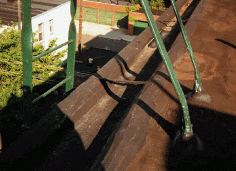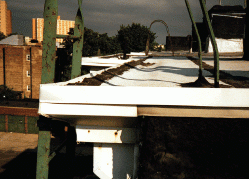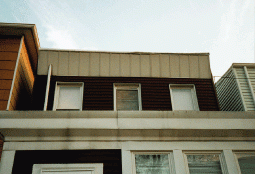Articles
Menu
- Promotional Assessment Centers, Understanding the process
- Lifeline Search: A Systematic Approach
- SCBA Basics
- Yankee Gutters: The Hidden Danger
- Tools For Managing The Incident
- Roof Operations: Listen, Look and Cut
- False Peaks: Help or Hindrance to Firefighting Operations?
- Water Supply: The Operating And Supply Pumper Concept
- The Jersey City Effort
- Size-Up: Updating An Old Acronym
- Jersey City Waterfront Triage
- Fireground Size-Up For Factory and Warehouse Fires
- Fireground Size-Up: Row Frames
- Fireground Size-Up For Garden Apartments And Townhouses
Yankee Gutters: The Hidden Danger
With the passing of time, the Yankee gutter, or “wooden gutter”–an aesthetic feature of many old homes–has become a serious safety hazard for today`s firefighters. This type of gutter, found on many private and multiple dwellings in urban areas today, is most often a feature of the brownstone, Queen Anne, Victorian, and row house types of structures.
A molded piece of ornamental oak or pine wood averaging from six to 12 inches in width, the gutter often spanned the entire width of the house as one solid piece. Designed to divert rainwater from dwelling roofs, it was milled to form the classic “U” shape associated with a rain gutter.
The gutter was fastened to the building in various ways. It was often nailed to the roof rafters, eliminating the need to install a fascia board. In other cases, copper straps were attached to the roof deck surface or a decorative wood support was fastened at the roof line. When initially installed (in some structures, this was more than a hundred years ago), this ornamental piece of wood was often painted, stained, or wrapped with copper to match the decor.
THE HAZARDS
The threats these gutters pose to firefighter safety arise from the fact that many of these gutters have not been properly maintained over the years. At one time, the gutter performed its function of catching and channeling rainwater from a building`s roof deck to an awaiting leader (vertical channel) that would eventually take the water to the ground. However, the continuous exposure of the wood to rainwater and other elements of nature and the failure to maintain them have caused these gutters to dry out and rot. These once decorative features became nothing more than rotting, decaying pieces of hanging wood.
REPAIRS ALSO ADD HAZARDS
The risk to firefighters has not been eliminated even in those structures where attempts were made to repair these gutters so they could perform their intended function. Roofers generally made two types of repairs to save money for the homeowner. The first approach was to coat a leaky gutter with roofing (flashing) cement to prevent further rot and allow some type of water runoff. If the gutter continued to leak, the roofer then applied a new layer of roof decking that extended over and covered the gutter. In some cases, this made the gutter almost undetectable and made it appear that there were six to 12 inches more of “roof deck.” This repair was often followed by adding a flimsy aluminum cornice that made the gutter even more undetectable from the street–thus hiding from firefighters the inherent dangers those modifications created.
Another problem uncovered in the Jersey City (NJ) Fire Department`s building familiarization program is that building contractors have taken shortcuts when applying new vinyl or aluminum siding. Among them was removing the wooden gutter supports, instead of boxing around them, so contractors could continue applying straight pieces of siding. The gutter was now completely unsupported.
The dangers of the Yankee gutter were brought to my attention years ago when I was a new probationary firefighter assigned to Ladder Co. 12 in Jersey City. There I met a veteran firefighter who for years had moonlighted as a roofer in the city. Since I was a brand new firefighter and a part-time roofer, he took me under his wing and explained the different facets of roof construction design and their inherent defects as we worked on these roofs at different fires or as we repaired them throughout the city.
He repeatedly reminded me about the Yankee gutter. With its constant repairs, patches, and false roof deck extensions, this once ornamental and well-constructed gutter now could cause an unsuspecting firefighter to fall to his death. As a standard practice, we attempted to identify these conditions as we made our way to the roof during a fire and alerted all members. In incidents where the smoke blanketed the roof deck, we made it a practice to stay clear of the last 12 inches of roof deck, anticipating the possibility of the presence of the unsupported, rotted area often associated with this type of gutter. A simple yell, “Giant step,” would remind us not to step or put any weight on this area as we ascended to or descended from the roof.
Yankee gutters are still hanging off many buildings throughout the country. Their presence is often hidden and may not be easily detectable. Plan as if one is there whenever you work on a structure that has a potential for its presence because of its age or construction type. Make it a habit to look before you step.



(Top left) This Yankee gutter, on the rear of the building, has been tarred over numerous times. (Photos by author.) (Top right) The same gutter viewed from below shows the wood supporting members. (Bottom left) A new roof extended over an existing wooden gutter. From above, it appears to be part of the roof deck. (Bottom right) The roof deck extension over an existing Yankee gutter is hidden by an aluminum cornice. Notice the leader (downspout) that disappears into the cornice.
